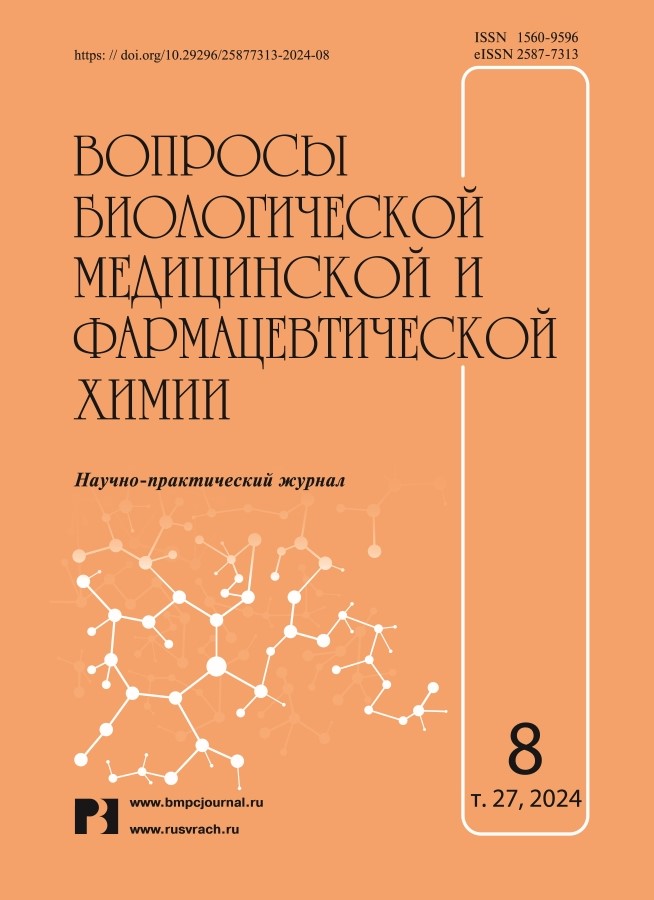Selection and evaluation of conservation conditions of Claviceps purpurea saprophytic lines
- 作者: Volnin A.A.1, Bobyleva R.I.1, Tsybulko N.S.1, Savin P.S.1, Shtrom K.A.2, Myasnikova S.B.1, Bokhan A.I.1
-
隶属关系:
- All-Russian Scientific Research Institute of Medicinal and Aromatic Plants
- MIREA – Russian Technological University (Moscow State University of Fine Chemical Technologies named after Lomonosov)
- 期: 卷 27, 编号 8 (2024)
- 页面: 50-58
- 栏目: Biological chemistry
- URL: https://journals.eco-vector.com/1560-9596/article/view/635311
- DOI: https://doi.org/10.29296/25877313-2024-08-07
- ID: 635311
如何引用文章
详细
Introduction. Ergot Claviceps purperea plays an important role in health-care technologies. Accumulation of genetic resources of industrial pharmaceutical strains of parasitic ergot is the actual scientific problem. This work is devoted to development of selection and evaluation of conservation conditions of Claviceps purpurea saprophytic lines.
Conidiospores and saprophytic mycelium were frozen at –20 0C, after 10 months of storage and cultivated in Erlenmayer flasks on a liquid medium and on an agarised medium. Cryopreserved samples of conidiospores and mycelium retained the ability to grow and alkaloids biosynthesis in vitro.
Results. The best lines were selected from sclerotias of 3 parasitic strains and deposited in the form of axenic and saprophytic mycelium for long-term storage (ergotoxin ВКМ-F-2450-D-23-1, ergotoxin ВКМ-F-2450-D-23-9, ergotamine ВКМ- F-2641-D-S-2, ergocornam ВКМ-F-3662-D-22-5).
Sclerotia of ergotamine-producing strain had a level of alkaloid synthesis of 0.78 g/100 g, with an ergotamine content of 67.9%, and demonstrated of pigmented purple mycelium in axenic culture. Sclerotias of ergotoxin-producing strain – 0.76 and 0.59 g/100 g, containing 51.5 and 50.3% of the sum of ergocornine and α-ergocryptine, 20 and 22% of β-ergocryptine, respectively, both lines demonstrated sclerotia-like mycelium and alkaloids biosynthesis in saprophytic cultivation on agarised medium. Sclerotia of ergocornam-producing strain – 0.79 g/100 g, containing 18.2% of ergocornam and 24.6% of ergometrine, demonstrated pigmented purple mycelium in axenic culture.
Conclusion. Development of long-term storage biocollections, including cryocollections for organisms producing pharmaceuticals raw substances, creates the basis for technological sovereignty of the Russian Federation. It is reducing dependence on imported drugs and pharmaceuticals raw substances, including ergoalkaloids.
全文:
作者简介
A. Volnin
All-Russian Scientific Research Institute of Medicinal and Aromatic Plants
编辑信件的主要联系方式.
Email: volnin.a@mail.ru
ORCID iD: 0000-0001-9222-536X
Ph.D. (Biol.), Leading Research Scientist, Laboratory of Biotechnology
俄罗斯联邦, 7, ul. Grina, Moscow, 117216R. Bobyleva
Email: volnin.a@mail.ru
к.б.н.
俄罗斯联邦N. Tsybulko
All-Russian Scientific Research Institute of Medicinal and Aromatic Plants
Email: volnin.a@mail.ru
ORCID iD: 0000-0001-9542-5017
Ph.D. (Pharm.), Engineer, Laboratory of Biotechnology
俄罗斯联邦, 7, ul. Grina, Moscow, 117216P. Savin
All-Russian Scientific Research Institute of Medicinal and Aromatic Plants
Email: volnin.a@mail.ru
ORCID iD: 0000-0002-5441-3471
Ph.D. (Biol.), Leading Research Scientist, Laboratory of Biotechnology
俄罗斯联邦, 7, ul. Grina, Moscow, 117216K. Shtrom
MIREA – Russian Technological University (Moscow State University of Fine Chemical Technologies named after Lomonosov)
Email: volnin.a@mail.ru
Master
俄罗斯联邦, Vernadsky Avenue, 86, Moscow, 119454S. Myasnikova
All-Russian Scientific Research Institute of Medicinal and Aromatic Plants
Email: volnin.a@mail.ru
ORCID iD: 0000-0002-6318-2433
Research Scientist, Laboratory of Biotechnology
俄罗斯联邦, 7, ul. Grina, Moscow, 117216A. Bokhan
All-Russian Scientific Research Institute of Medicinal and Aromatic Plants
Email: volnin.a@mail.ru
ORCID iD: 0000-0003-4154-3709
Dr.Sc. (Agrical.), Head of Laboratory of Biotechnology
俄罗斯联邦, 7, ul. Grina, Moscow, 117216参考
- Volnin A.A., Savin P.S. Raznoobrazie alkaloidov i virulentnost' sporyn'i Claviceps purpurea (Fries) Tulasne: jevoljucija, geneticheskaja diversifikacija, metabolicheskaja inzhenerija (obzor). Sel'skohozjajstvennaja biologija. 2022; 57(5): 852–881. doi: 10.15389/agrobiology.2022.5.852rus.
- Wong G., Lim L.R., Tan Y.Q. et al. Reconstituting the complete biosynthesis of D-lysergic acid in yeast. Nature Communication. 2022; 13(1): 712. doi: 10.1038/s41467-022-28386-6.
- Chen J., Han M., Gong T. et al. Recent progress in ergot alkaloid research. RSC Advances. 2017; 7(44): 27384–27396. doi: 10.1039/C7RA03152A.
- Hulvová H., Galuszka P., Frébortová J., Frébort I. Parasitic fungus Claviceps as a source for biotechnological production of ergot alkaloids. Biotechnology Advances. 2013; 31(1): 79–89. doi: 10.1016/j.biotechadv.2012.01.005.
- Yao Y., Wang W., Shi W. et al. Overproduction of medicinal ergot alkaloids based on a fungal platform. Metabolic Engineering. 2022; 69: 198–208. doi: 10.1016/j.ymben.2021.12.002.
- Volnin A.A., Cybul'ko N.S., Savin P.S. i dr. Biokollekcija farmacevticheskih parazitarnyh shtammov sporyn'i purpurnoj – osnova dlja selekcii novyh linij, producirujushhih jergoalkaloidy in vitro. Voprosy biologicheskoj, medicinskoj i farmacevticheskoj himii. 2023; 26(8): 22–31. doi: 10.29296/25877313-2023-08-03.
- Shain S.S. Biologicheskie osnovy proizvodstva syr'ja sporyn'i (Claviceps purpurea (Fr.) Tul.) v biotehnologicheskoj sisteme grib–rastenie (obzor). Prikladnaja bio-himija i mikrobiologija. 1996; 32(3): 275–279.
- Fonin V.S., Sidjakina T.M., Shain S.S. i dr. Izuchenie uslovij hranenija promyshlennyh shtammov parazitarnoj kul'tury sporyn'i. Prikladnaja biohimija i mikrobiologija. 1996; 32(4): 406–410.
- Volnin A.A., Cybul'ko N.S., Savin P.S., Mjasnikova S.B. Jekspress-metody selektivnogo i neselektivnogo opredelenija indol'nyh alkaloidov. Veterinarija, zootehnija i biotehnologija. 2022; 12(1): 117–126. doi: 10.36871/vet.zoo.bio.202212115.
- Mantle P. Comparative ergot alkaloid elaboration by selected plectenchymatic mycelia of Claviceps purpurea through sequential cycles of axenic culture and plant parasitism. Biology (Basel). 2020; 9(3): 41. doi: 10.3390/biology9030041.
- Mantle P.G., Tonolo A. Relationship between the morphology of Claviceps purpurea and the production of alkaloids. Transactions of the British Mycological Society. 1968; 51(3-4): 499–505. doi: 10.1016/s0007-1536(68)80017-8.
- Pohilenko V.D., Baranov A.M., Detushev K.V. Metody dlitel'nogo hranenija kollekcionnyh kul'tur mikroorganizmov i tendencii razvitija. Izvestija vysshih uchebnyh zavedenij. Povolzhskij region. Medicinskie nauki. 2009, 4(12): 99–121.
- Gabitova G.H., Shajdullina M.Z., Gur'janov I.D., Reshetnik O.A. Sposoby deponirovanija hlebopekarnyh drozh-zhej. Vestnik tehnologicheskogo universiteta. 2017; 20(18): 152–157.
- Savkina O.A., Ternovskoj G.V., Lokachuk M.N. i dr. Kriokonservacija – perspektivnyj metod hranenija promyshlenno cennyh shtammov molochnokislyh bakterij i drozhzhej. Sel'skohozjajstvennaja biologija. 2014; 4: 112–119. doi: 10.15389/agrobiology.2014.4.112rus.
补充文件






